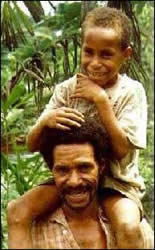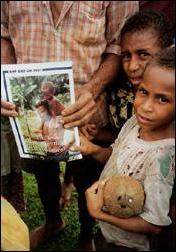 A year ago Aniap appeared, perched on the shoulders of her father, Atani Wungmo, on the front of a BHP publication circulated throughout Australia. At that time no one knew who she was or where she lived, except that she was of the Yonggom people from the Ok Tedi area. A reader drew attention to her. She didnt look well. Was she all right? So we went looking for her.
A year ago Aniap appeared, perched on the shoulders of her father, Atani Wungmo, on the front of a BHP publication circulated throughout Australia. At that time no one knew who she was or where she lived, except that she was of the Yonggom people from the Ok Tedi area. A reader drew attention to her. She didnt look well. Was she all right? So we went looking for her.
It took a while, with village people anxious over compensation for mine-related environmental change. After the settlement, Ok Tedi Mining Limited medical officer Dr. Stephen Flew found himself working in Dome, a village near BHP Coppers Ok Tedi mine. As he had been doing elsewhere, he asked village people whether they knew the anonymous couple in the photo.
"Yes, thats me and, yes, thats my little girl and, yes, shes in good health thank you. Atani told me," Dr. Flew says. Aniap is the fifth of Atanis seven living children, the first born having died of fever (probably malaria).
Dr. Flew reports that Aniap has grown quite well even though she was small at birth. She is healthy and lively, despite the bouts of malaria, middle ear and respiratory infections that afflict virtually all village children in that part of PNG. She has also completed a full course of immunizations against tetanus, whooping cough, diphtheria, polio, tuberculosis and measles.
There in neat black notations is Aniaps medical history. It includes her birth on December 8, 1987, at Rumginae Health Centre weighing 2.5kg, and her monthly record of growth, state of health and immunizations.
The brown booklet is looking a little worn now. After all it is nearly nine years old, and in the tropical sogginess of the Fly River region, staying in shape for any length of time requires constant care.
Anxious mothers clutch these precious booklets as they present their children for treatment at health centers and aid posts scattered sparsely throughout PNG. In the north Fly, these medical records are at once sources of comfort and hope, and of anxiety and frustration.
Comfort and hope, because the booklets document in detail a dramatic improvement in health and life expectancy. This in an area where malaria and tuberculosis are endemic, and other plagues such as polio visit regularly. Anxiety and frustration, because of the constant struggle, with rudimentary tools and severely limited resources, against a tide of disease, dietary deficiencies and hygiene inadequacies.
The balance has been tipping positively with the building of the Ok Tedi mine, the town of Tabubil and the necessary infrastructure. The projects influence spreads far beyond the mine lease boundaries.
 The modern health care facilities OTML established at Tabubil serve the mines workforce and its immediate community. Even more importantly, perhaps, OTML supplements the efforts of government and mission health care workers by giving them mobility and access to expertise. Aniaps people know there is a chain of support they can rely on for treatment and advice. At Dome, first stop is the village aid post for dispensation of pills and potions, bandages and disinfectant. More serious cases go to Rumginae, only 15km away in distance but a solid trek on foot and a couple of hours by boat (the usual means of transport). Emergency cases are flown by OTML helicopter to the hospital at Tabubil.
The modern health care facilities OTML established at Tabubil serve the mines workforce and its immediate community. Even more importantly, perhaps, OTML supplements the efforts of government and mission health care workers by giving them mobility and access to expertise. Aniaps people know there is a chain of support they can rely on for treatment and advice. At Dome, first stop is the village aid post for dispensation of pills and potions, bandages and disinfectant. More serious cases go to Rumginae, only 15km away in distance but a solid trek on foot and a couple of hours by boat (the usual means of transport). Emergency cases are flown by OTML helicopter to the hospital at Tabubil.
Physical resources, such as buildings, may be less crucial then health professionals, but they are certainly wanted by the people. At the villagers request, the OTML-sponsored Lower Ok Tedi/Fly River Development Trust has built 19 aid posts in the past five years and taken part in joint ventures building health subcentres. Indeed, the aid post at Aniaps home village, Dome, is the work of the trust.
"Aniap is quite a lively little girl who is just starting her first year at school," Dr. Flew says. "She has indeed done well to survive the trials and tribulations of growing up in a highly malaria and tuberculosis-endemic area, thanks largely to the care and attention she has regularly received from the mission health center."
Strengthening the grip on life of every little Aniap requires strengthening the health care structureshealth workers from the local communities being trained in those communities and going back to work there, the provision of rural health services and primary health care, and the collaboration between resource-rich developers and resource-poor health agencies are what make it all work.
Cataracts affect more than 30,000 people throughout Papua New Guinea (PNG), a far-flung country of mountains, swamps and islands where reaching people is difficult and expensive. In the Fly River region, this is where Ok Tedi Mining Limiteds (OTML) participation is probably most valuable. Dr. Nitin Verma, an eye specialist at the Port Moresby hospital, is pursuing a national program that aims to eliminate cataract-caused blindness in PNG by 2000. OTML is working with the Rumginae center and Dr. Vermas team from the Port Moresby hospital to treat eye cataracts. A mobile surgery unit was developed by Dr. Verma and loaded on the research vessel, Western Venturer (a ship refurbished by OTML). The surgical unit traveled south, operating on about 250 people, removing cataracts and implanting plastic lenses. The surgical team has not yet visited the North Fly, but operable cataracts have been diagnosed on 132 people.
Attribution
This article is reprinted with permission from the publication, On CU, April - June, 1997, Vol. 1, No. 2.
On CU
is the quarterly publication of BHP Copper, a business group of The Broken Hill Proprietary Corp., Ltd.
© 1997 BHP Copper
![]()
BHP Copper
550 California Street
San Francisco,
California 94104
